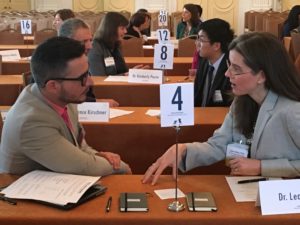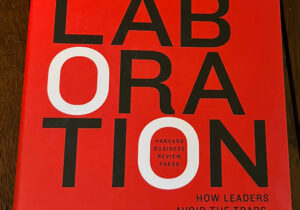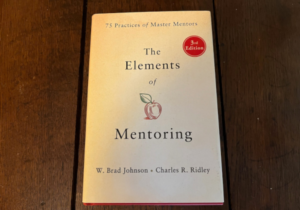Speed Mentoring: Seven Steps to a Successful Session

Speed mentoring is a riff on speed dating that allows trainees and early career faculty to meet multiple mentors in a short time. Have you ever wished you could have ten minutes for advice or conversation with an experienced researcher outside your immediate circle of mentors? This is a great way to arrange that opportunity.
We host speed mentoring at our institution and at the national Translational Science conference. One hour with five separate conversations is a practical format. Here’s what we have learned about organizing a session so you have a recipe for holding your own speed mentoring. (Sample materials available at the end of this post.)
Step 1
 Find the right date and space. Coordinating with other activities can be ideal. Slip speed mentoring into an afternoon breakout during a campus research forum or add it before the annual mentoring awards and career development event. For the venue, aim for the sweet spot between everyone being close enough to move easily and quickly between mentors, and not being so packed together that it’s hard to hold a private conversation.
Find the right date and space. Coordinating with other activities can be ideal. Slip speed mentoring into an afternoon breakout during a campus research forum or add it before the annual mentoring awards and career development event. For the venue, aim for the sweet spot between everyone being close enough to move easily and quickly between mentors, and not being so packed together that it’s hard to hold a private conversation.
Step 2
Collect your pool of mentees and mentors to invite. Works best with twenty or more of each. This allows matching by research interests and career focus while avoiding pairing mentees with their own mentors or collaborators. Two good sources for identifying mentors, beyond the usual leaders associated with career development programs are your institution’s database of funded investigators and conference registrations if you are taking speed mentoring on the road.
To get your target number you’ll need to ask a large pool of mentors. A ratio of 2 invites for each 1 mentor needed is a good place to start if you plan early given the calendar constraints and travel of senior faculty. Depending on the size of group, plan to have 2 to 3 extra mentors on standby to cover last minute cancellations, with 1 or 2 attending the event as backup for no shows. (Nothing sadder than an empty slot on your dance card.) As you confirm RSVPs from mentees also keep a wait list of mentees to add if others drop.
Step 3
Use a survey in advance to help tailor matches. This helps you avoid matching people who already know each other well, and lays the foundation for matching mentors and mentees with similar research content and expertise areas. (Sample survey items at the bottom of post.) When holding sessions locally, we also ask mentees to list their mentors, collaborators, and anyone they would prefer not to be matched with because they already have access to the individual.
Step 4
Match mentors and mentees. For an hour long session, plan for five pairings for each person; this allows a five minute intro, nine minutes for a mentee to talk to each mentor, and two minutes for transition time between each pairing. To make pairs, the goal is to maximize the total number of content and methodologic areas (or other features you select like gender or department) that match between a mentor and a mentee. We use an optimization modeling program in SAS. Matching can also be done by hand or using spreadsheets. Start with getting each mentee a very high quality match and then proceed to make the next rounds remembering not to use a mentor more than five times.
Step 5
 Assign your participants to spots in the room. Seniority has benefits; we let our mentors keep their seats and mentees move around the room. We use table stands with a number on them to ensure people can quickly see where they need to be, as well as a table tent with each mentor’s name.
Assign your participants to spots in the room. Seniority has benefits; we let our mentors keep their seats and mentees move around the room. We use table stands with a number on them to ensure people can quickly see where they need to be, as well as a table tent with each mentor’s name.
Make a large poster of table assignments for mentors and first table assignment for mentees so everyone can quickly find their spot at the start of a session.
Step 6
Create individual schedules for each mentor and mentee. Place them at their starting table. (Templates below.)
We also provide a list of questions to mentees to help get the conversation started:
- What’s your single best piece of grant-writing/preparation/submission advice?
- How did you recover from your biggest failure?
- Have you ever run into a sticky situation with internal politics and how did you solve it?
- What are the best ways to connect with busy senior faculty and administrators?
- How do you integrate your work and your personal life?
- What’s the most important thing for someone at my career stage to do in the next six months?
Other things to place at each table include bottled water, paper and pens—we see a lot of note taking at these events!
Step 7
Have a moderator and keep strict time! Mentor/mentee pairs inevitably get caught up in conversation. To avoid drift and ensure each pair gets the full nine minutes, your moderator will need to be firm and persistent about making sure everyone moves at the same time.
If possible send a feedback survey to participants by email that includes some space for open ended comments. Thank mentors for their time in person at the end of the event and afterwards including comments from mentees about why they valued the opportunity.
Best wishes as you build new connections among mentors and mentees.
Materials
- Example email – request for mentors to serve
- Example email – advertising to mentees
- List of suggested survey questions
- Template schedule – Mentor
- Template schedule – Mentee
- Example timeline for setup and execution
Contact us at info@edgeforscholars.org if you need more details before you launch.






4 Comments
[…] newer forms of mentoring are flourishing: reverse mentoring, mentoring circles, and speed mentoring. These new and dynamic forms of mentoring are re-shaping the idea of mentoring, with traditional […]
its an impressive concept. I will use it some day. thank you